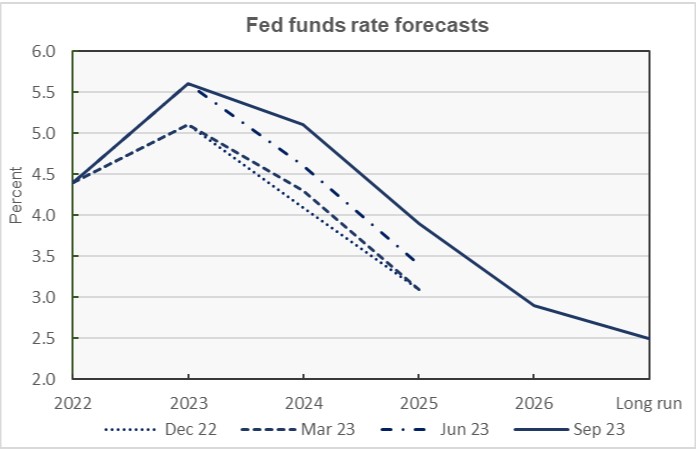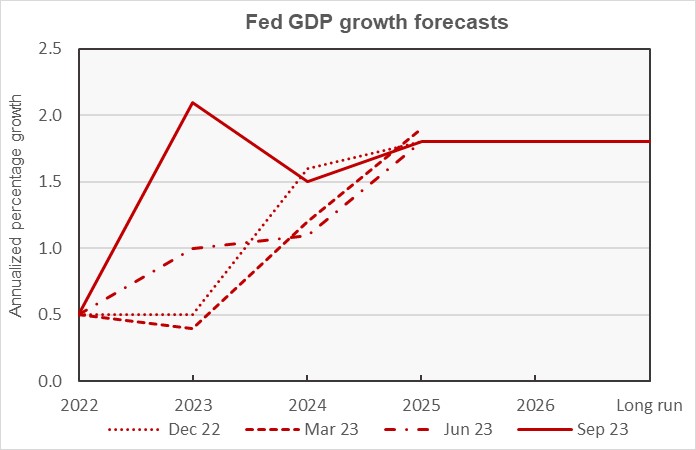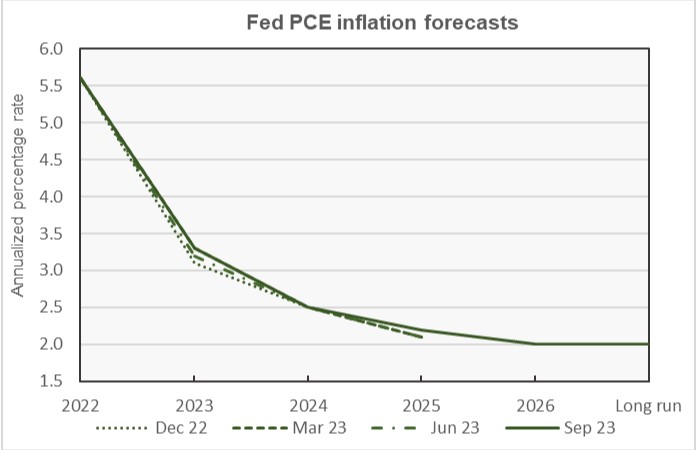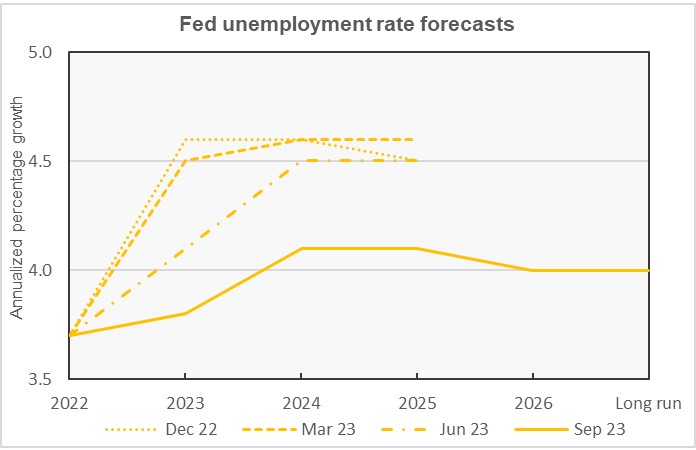Federal Open Market Committee (FOMC) met this week and decided to keep interest rates unchanged. However, the Federal Reserve’s updated forecasts for key economic metrics projected that interest rates may remain high for longer than they had expected in the past.
The FOMC meets 8 times per year but only releases an economic forecast at 4 of the meetings. The Fed forecast presents estimates for economic metrics by year, now through 2026, and a “longer run” forecast which reflects their view of the output of the economy if operating at equilibrium. The consensus Fed forecast is developed by the combining the forecasts of 18 economists. Each of the economists assumes that the Fed will follow “appropriate” monetary policy during the term of the forecast, although their individual ideas of what that policy is may vary.
Interest rates decline delayed
The headline news coming out of the recent Fed meeting was their decision to keep interest rates unchanged for now. However, they raised their estimate of the appropriate Federal Funds interest rate for year-end 2024 by 0.5 points to 5.1 percent. This, along with their upward revision to their GDP forecast for 2023, indicates that the Fed thinks that they will have to keep interest rates elevated for longer to cool inflation.
The Fed now predicts that the appropriate Federal Funds rate for 2025 will be 3.9 percent, up 0.5 percentage points from their last projection. The Fed’s introductory prediction of the appropriate Federal Funds rate for 2026 is 2.9 percent, slightly above their longer-run rate of 2.5 percent.
A history of the forecasts for the Federal Funds rate is given in the first chart, below.

GDP near-term expectations rise
Fed’s current forecast for GDP growth in 2023 was raised 1.1 percentage points to 2.1 percent. The Fed also raised its 2024 GDP forecast to 1.5 percent, up 0.3 percentage points since their last projection. The Fed’s GDP forecast for 2025 was left unchanged at 1.8 percent, which is also their longer-run equilibrium rate.
Because the Fed does not release projections by quarter, it is hard to say whether they believe that they will bring inflation under control without inducing a recession, if a recession is defined as 2 quarters of negative GDP growth. However, the fact that the lowest annual GDP growth in their current forecast is 1.5 percent in 2024 implies that they believe any slowdown in activity will be shallow and/or short-lived.
The continued strength of the economy in the face of interest rate rises has been a surprise to the Fed. Of the range of estimates for GDP growth for 2023, only one of the 18 estimates from the June projection falls within the range of estimates presented at the September meeting.
Recent Fed GDP forecasts are illustrated in the next chart, below.

Inflation outlook nearly unchanged
The Federal Reserve’s preferred inflation measure is based on the Personal Consumption Expenditures (PCE) survey, rather than the more familiar Consumer Price Index (CPI). The Fed now expects year-end PCE inflation in 2023 to come in at 3.3 percent, up 0.1 percentage point since their June forecast. The PCE inflation forecasts for 2024 was left unchanged at 2.5 percent but the inflation forecast for 2025 was raised 0.1 percentage point to 2.2 percent. The Fed expects to achieve their target rate for PCE inflation of 2.0 percent in 2026.
The history of the Fed’s recent PCE inflation forecasts is shown in the next chart.

Unemployment forecast to be lower
The current Q4 2023 unemployment rate is forecast to be 3.8 percent, down 0.3 percentage points from the June forecast. The Fed forecasts that the Q4 unemployment rate will rise to 4.1 percent in 2024 and remain at that level in 2025. Both values are down 0.4 percentage points from those in the June forecast.
The Fed’s inaugural forecast for 2026 is for the Q4 unemployment rate to be 4.0 percent, matching their expected longer-run unemployment rate for the U.S. economy.
The history of the Fed’s recent unemployment rate forecasts is shown in the next chart.

The next updates to the Federal Reserve’s forecasts for the economy will come after the December 2023 FOMC meeting.















